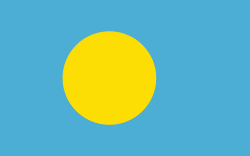Aimeliik (State of Aimeliik)
Aimeliik is an administrative division of the island country of Palau. It is one of the Republic of Palau's 16 states. It has an area of 52 km² and a population of 334 (census 2015). State capital is the village of Mongami. Following the four other villages which are: Medorm, Imul, Elechui and Ngmechiangel.
The island is the location to Palau's largest powerplant. The state is also a short distance from the international airport. In the village of Medorm there is the highest powered short wave radio station in Palau. This is owned and operated by High Adventure Ministries originally from the US but now owned by a consortium of Chinese national churches. It comprises four short wave transmitters two are Thomson which originally came from Adventist Radio in Guam the others are a venerable Harris transmitter and a 30-year-old RCA transmitter all feeding several stacked curtain arrays which are beamed on South East Asia. They operate mainly on the 9 and 15 MHz Bands.
At least seven traditional village sites existed in Aimeliik, Medorm, Ngchemiangel, Ngebedech, Chelechui, Ngerkeai, Imul, and Ngerderar. These settlements were focused on the rich soil with a mixed forest on a thin strip of land along the coast and around the bay.
Within villages are numerous stone features with historical and traditional importance. Many stone platforms, odesongel, serve as clan cemeteries, while other stone features serve as shrines.
The lagoon and Ngchemiangel Bay are important resource areas, and were probably intensively exploited prehistorically. Important resources include mangrove trees and many species of fish. In and around traditional villages are taro swamp gardens and garden plots, and surrounding many village sites are terraced hillsides.
The territory was governed by Spain until 1899 when it was sold to Germany. In 1919 it became a Japanese possession until the United States took control after World War II. Aimeliik is one of the most ancient villages in Palau. It is best known for its terraces and modern bai. Aimeliik is also known for Malsol's Tomb, the legendary spot where the warrior Malsol is buried, which is now accessible through the main road and near the Aimeliik bai. Aimeliik is commonly passed through on the main road of the Babeldaob Island.
The island is the location to Palau's largest powerplant. The state is also a short distance from the international airport. In the village of Medorm there is the highest powered short wave radio station in Palau. This is owned and operated by High Adventure Ministries originally from the US but now owned by a consortium of Chinese national churches. It comprises four short wave transmitters two are Thomson which originally came from Adventist Radio in Guam the others are a venerable Harris transmitter and a 30-year-old RCA transmitter all feeding several stacked curtain arrays which are beamed on South East Asia. They operate mainly on the 9 and 15 MHz Bands.
At least seven traditional village sites existed in Aimeliik, Medorm, Ngchemiangel, Ngebedech, Chelechui, Ngerkeai, Imul, and Ngerderar. These settlements were focused on the rich soil with a mixed forest on a thin strip of land along the coast and around the bay.
Within villages are numerous stone features with historical and traditional importance. Many stone platforms, odesongel, serve as clan cemeteries, while other stone features serve as shrines.
The lagoon and Ngchemiangel Bay are important resource areas, and were probably intensively exploited prehistorically. Important resources include mangrove trees and many species of fish. In and around traditional villages are taro swamp gardens and garden plots, and surrounding many village sites are terraced hillsides.
The territory was governed by Spain until 1899 when it was sold to Germany. In 1919 it became a Japanese possession until the United States took control after World War II. Aimeliik is one of the most ancient villages in Palau. It is best known for its terraces and modern bai. Aimeliik is also known for Malsol's Tomb, the legendary spot where the warrior Malsol is buried, which is now accessible through the main road and near the Aimeliik bai. Aimeliik is commonly passed through on the main road of the Babeldaob Island.
Map - Aimeliik (State of Aimeliik)
Map
Country - Palau
 |
 |
| Flag of Palau | |
The country was originally settled approximately 3,000 years ago by migrants from Maritime Southeast Asia. Palau was first drawn on a European map by the German missionary Paul Klein based on a description given by a group of Palauans shipwrecked on the Philippine coast on Samar. Palau islands were made part of the Spanish East Indies in 1885. Following Spain's defeat in the Spanish–American War in 1898, the islands were sold to Germany in 1899 under the terms of the German–Spanish Treaty, where they were administered as part of German New Guinea. After World War I, the islands were made a part of the Japanese-ruled South Seas Mandate by the League of Nations. During World War II, skirmishes, including the major Battle of Peleliu, were fought between American and Japanese troops as part of the Mariana and Palau Islands campaign. Along with other Pacific Islands, Palau was made a part of the United States-governed Trust Territory of the Pacific Islands in 1947. Having voted in a referendum against joining the Federated States of Micronesia in 1978, the islands gained full sovereignty in 1994 under a Compact of Free Association with the United States.
Currency / Language
| ISO | Currency | Symbol | Significant figures |
|---|---|---|---|
| USD | United States dollar | $ | 2 |
| ISO | Language |
|---|---|
| ZH | Chinese language |
| EN | English language |
| JA | Japanese language |















